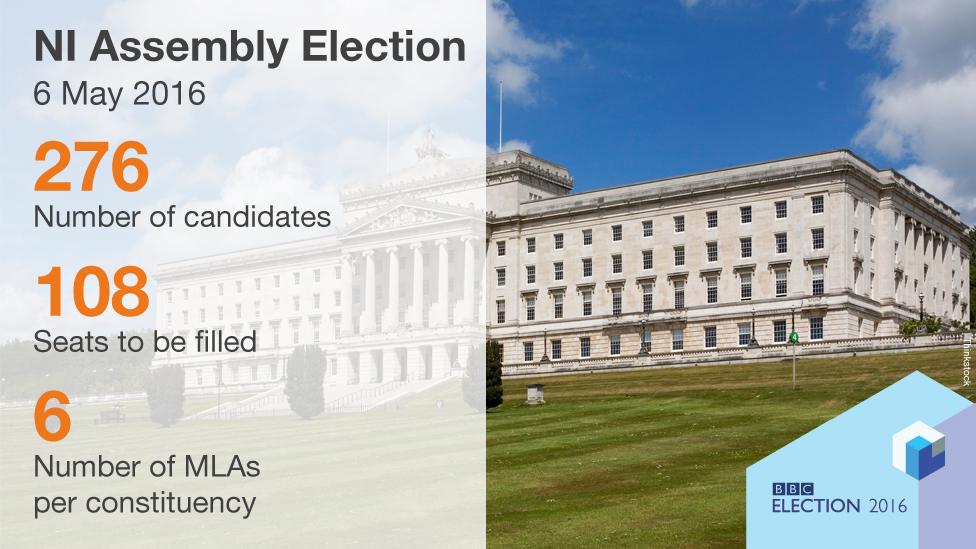NI Assembly election: The numbers game
- Published

During this campaign there has been a lot of discussion about who might end up as Stormont's biggest party.
Back in 2011 the DUP secured 38 seats and Sinn Féin 29.
On the face of it, that's a big gap to close.
Even though Sinn Fein secured a greater percentage of the vote than the DUP in the council and European elections back in 2014, the lower turnout and lower quotas in predominantly unionist seats to the east of Northern Ireland seem to give the DUP an inbuilt advantage in Assembly elections.
Securing top spot and earning the right to the First Minister's job is obviously the big prize.
But it is not the only target the Stormont politicians might have in mind.
Another one is ensuring your party has 30 MLAs.
That's the number of votes you need to trigger a valid petition of concern - the mechanism used by Stormont parties to require a cross community vote on a measure they oppose - which can then be used to block the initiative.

The persistent resort to petitions of concern came in for widespread criticism during the last Assembly term, and November's Fresh Start Agreement included proposals designed to limit their use.
Nevertheless, party chief whips would much prefer to have the blocking weapon in their locker than not.
With 38 MLAs in the last mandate, the DUP could table a petition of concern whenever they wished.
However with just 29, Sinn Féin always needed to persuade at least one MLA outside the party to join forces in signing a petition - depending on the issue under consideration that tended to put the SDLP, Greens or Alliance in a pivotal position.
No doubt Sinn Féin would prefer to be able to wield a veto, or even threaten to use a veto, under its own steam. To do that they need to make at least one gain.
If appointing a First Minister or having a veto is beyond a party's grasp, its MLAs can still hope to have enough clout to get their hands on a Stormont department.
There is no fixed number of MLAs which qualifies you for a ministry in advance of the election.
Instead, it depends on how many seats other parties win, and is allocated according to what's known as the D'Hondt proportional system (named after the Belgian mathematician of the same name).

The terms agreed in the Fresh Start deal include provisions for the formation of an official opposition
Last time the Alliance party squeezed into the Stormont Executive on the basis of securing just 8 seats.
This meant they did as well in the D'Hondt lottery as the Ulster Unionists who had 16 MLAs and the SDLP who had 14.
The maths proved particularly controversial as Alliance also gained a ministry via a special cross community election applied to the Justice department, giving them twice as much representation at the Executive table as parties double their size.
This has been addressed under the Fresh Start deal, so the Justice department will be allocated first and whoever gets it will lose one of their picks under the D'Hondt system.
On top of this, the overall number of Stormont departments is being cut from 12 to 9.
One department - the new Executive Office - is reserved for the biggest two parties. One minister - Justice - will be elected on a cross community basis.
So that means 7 departments will be up for grabs under D'Hondt.
How many MLAs will a party need to get that 7th pick?
We can't say for sure, but it's almost bound to be higher than the 8 MLAs Alliance got last time.
One seasoned observer told me he thought 11 might be the new threshold for government.
That's still a guess, albeit an educated one.

The overall number of Stormont departments is being cut from 12 to 9
Under the Fresh Start deal, a party which qualified for a place in the power sharing coalition but which didn't want to take it would, for the first time, qualify for recognition as Stormont's official opposition.
However, subsequent to that deal, back bencher John McCallister's private member's bill passed.
It defined a party qualifying for opposition status as one which chooses not to nominate a Minister or one "whose members comprise 8% or more of the total number of members of the Assembly, and which does not contain a member who is a Minister".
That 8% figure was the result of a bit of horse trading across the floor of the Assembly chamber between Mr McCallister and MLAs from the big parties.
With the Assembly retaining 108 seats for the next five years, it means a party might find solace in getting the recognition which goes with having just 9 MLAs.

The one figure no politician wants to be mulling over on 6 May is 150.
That's the number of pounds they have to provide as a deposit and the financial amount they stand to lose if they get less than a quarter of the quota in their constituency.